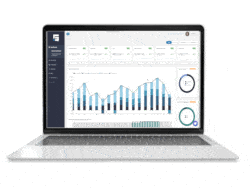In today’s competitive CRE landscape, insight into your portfolio’s performance is helpful and necessary. With data coming in from rent rolls, leases, expense ledgers, and appraisals, important indicators like Net Operating Income (NOI) can easily get buried in spreadsheets. Many owners and asset managers struggle to find a CRE dashboard that combines real-time insight with accounting accuracy. This guide walks you through evaluating CRE dashboard platforms, so you end up with a tool that actually improves decision-making instead of creating more work.
Understanding the Role of a CRE Dashboard
A CRE dashboard (or KPI dashboard) is a centralized interface that aggregates financial and operational data to present portfolio-level and asset-level KPIs visually. The point isn’t just about pretty charts; it’s about making faster, more confident decisions.
Why dashboards beat traditional reporting tools:
- They reduce manual reconciliation across systems.
- They provide near real-time visibility instead of stale monthly reports.
- They let different stakeholders (owners, asset managers, property managers) view tailored metrics without drowning in detail.
When your dashboard is aligned with accounting and leasing systems, you avoid errors that creep in when data is copied between spreadsheets and people.
Key Metrics: Tracking NOI and Portfolio KPIs
What is NOI (Net Operating Income)?
NOI = Total Revenue − Operating Expenses (excluding financing and taxes).
It’s the core measure of property performance because it isolates operating profitability regardless of capital structure.
Essential portfolio KPIs to track alongside NOI
- Occupancy/vacancy rates (impact revenue potential)
- Rent collection and delinquencies (cash flow risk)
- Expense ratios and capital expenditures (cost control)
- Tenant turnover and lease expirations (future income risk)
- Same-store NOI growth and portfolio-level trend lines
Make sure the dashboard supports customizable KPIs so you can present different views for owners, investors, or property management teams.
Core Features to Look For in a CRE Dashboard Platform
When evaluating platforms, insist on the following baseline capabilities :
1. Data Integration
Find a dashboard that seamlessly integrates with your current accounting, property management, or lease-tracking systems. It should integrate with utilities such as QuickBooks, Yardi, or MRI and be able to:
- Import rent rolls and payment history automatically.
- Pull detailed expense data straight from your general ledger.
- Map your chart of accounts across different entities to keep everything consistent.
The easier your data flows between systems, the less time you’ll spend on manual updates, and the more accurate your insights will be.
2. Automation & Real-Time Sync
Seek out on-demand refreshes and scheduled, automated syncs. While manual CSV uploads are fine as a temporary solution, they eventually lead to reconciliation issues.
3. Custom Reporting & Exports
You should be able to build filtered reports by property, ownership entity, or region and export to CSV, Excel, or PDF for investor packs.
4. Visualization
Dashboards should include trend lines (NOI over time), waterfall charts (revenue/expense drivers), heat maps for geographic performance, and tenant-level dashboards.
5. Scalability
Is there any performance lag when the platform manages hundreds of leases, multi-entity ownership, and consolidated roll-ups?
6. Security & Access Controls
SSO support, audit trails, and role-based access are essential for governance and compliance.
7. Mobile Accessibility
Executives and asset managers want quick KPIs on the road; mobile-friendly dashboards or apps matter.
If you’re evaluating STRATAFOLIO’s dashboard, check how it implements these features: flexible data mappings for NOI methodology, built-in connectors for common CRE systems, pre-built KPI templates for asset and portfolio views, and role-based reporting for owners vs. operators. STRATAFOLIO tends to emphasize rapid setup and automated reconciliations, verify the latency of data syncs, and the depth of export options during a demo.
Evaluating Dashboard Usability and User Experience
A powerful dashboard is worthless if your team won’t use it. Consider:
- Intuitive navigation: Can new users find the top-line NOI and drill into tenant or expense detail in two clicks?
- Clarity of visuals: Avoid dashboards that trade clarity for novelty; clear axes, readable labels, and sensible defaults are key.
- Onboarding & training: Does the vendor offer setup assistance, training sessions, and templates?
- Demo checklist: During demos, request to see (and interact with) a live dataset. Ask the vendor to walk through:
- Building a custom NOI calculation.
- Creating a portfolio roll-up report.
- Setting up user roles and permissions.
- Exporting an investor-ready report.
- Feedback & case studies: Ask for references with a similar portfolio size/strategy. Practical feedback on support, implementation time, and long-term reliability is invaluable.
Integration with NOI and Financial Tracking Tools
Data accuracy is the foundation of financial reporting. Make sure your dashboard aligns with your NOI methodology:
- Define your NOI rules upfront. Some teams include certain reserves or capitalized expenses; others do not. Your dashboard should let you configure these rules.
- Source-to-report workflows. Ideal flow: lease system → rent roll mapping → GL mapping → dashboard calculation → audit trail. Confirm each step is visible and auditable.
- Avoid data silos. Use a single source of truth for leases and GLs. If the platform pulls from multiple systems, confirm reconciling logic is transparent.
- Example workflows: Rent roll syncs daily, bank deposit feeds post receipts, and GL expense detail is mapped monthly. The dashboard then applies your NOI rules to produce consolidated reports and per-asset variance analyses.
Analyzing ROI: Is the Platform Worth It?
You should quantify efficiency gains. Here’s a simple arithmetic example (calculated step-by-step):
- Suppose manual monthly reporting takes 40 hours of staff time.
- After adopting a dashboard, reporting time drops to 8 hours.
- Time saved per month = 40 − 8 = 32 hours.
- If average loaded cost per hour = $60, monthly savings = 32 × 60 = $1,920.
- Annual savings = 1,920 × 12 = $23,040.
- If the platform costs $1,200/month, annual cost = 1,200 × 12 = $14,400.
- Net annual benefit = 23,040 − 14,400 = $8,640.
That’s a straightforward example, but don’t forget to include non-quantifiable value:
- Faster decisions on leasing or capex.
- Better investor transparency and trust.
- Reduced risk from accounting errors.
- Opportunity cost gains (e.g., capturing missed revenue opportunities faster).
Practical Checklist and Vendor Questions
When you’re sitting in on a product demo, don’t be afraid to dig deep. The right questions will help you see if the platform truly fits your workflow, not just looks good in a presentation. Here are a few conversation starters to keep handy:
- Which systems do you connect with natively?
Make sure it integrates smoothly with the tools you already use, like QuickBooks, Yardi, or your property management software.
- How often does the data refresh?
Ask if updates occur in real-time or on a set schedule. This makes a big difference in how “live” your insights really are.
- Can we customize how NOI is calculated?
Every company does this a little differently. Check if you can tweak the NOI formula and even save multiple versions for comparison.
- How do you handle chart-of-accounts mapping across entities?
This one’s huge if you manage multiple properties or ownership groups. You’ll want consistency without having to clean up data manually.
- Is there an audit trail?
Make sure you can track who changed what and when, especially if you’re reporting to investors or compliance teams.
- What user roles and permissions are available?
Not everyone needs access to every metric. Confirm you can set different access levels by property, region, or role.
- What export options do you support?
Investor-ready reports in Excel, PDF, or custom templates can save you hours each month.
- What does onboarding look like?
Ask about setup time, training, and whether they help migrate data or just hand you the keys.
- Can we try it with our own data first?
A sandbox or trial environment helps you see how the dashboard performs with real-world numbers.
- How is pricing structured?
Clarify whether it’s per user, per property, or a flat monthly fee, and if there are any hidden costs for integrations or support.
These questions will help you cut through the sales talk and see if the platform is built for your kind of commercial real estate business, not just the ideal demo scenario.
Red Flags
Here are a few red flags to keep an eye out for during your evaluation. If you spot these, it might be a sign to look elsewhere.
- No clear data lineage or audit trail.
- Export limitations (can’t produce investor pack).
- Manual-only connectors requiring repeated CSV work.
- Poor mobile responsiveness or missing role-based security.
Conclusion
The right CRE dashboard should empower you with actionable insights, not overwhelm you. Prioritize platforms that offer reliable integrations, configurable NOI logic, clear visualizations, and an experience your team will actually use.
Ready to simplify how you track NOI and portfolio KPIs? Schedule a demo today and see the difference a smart CRE dashboard can make.




